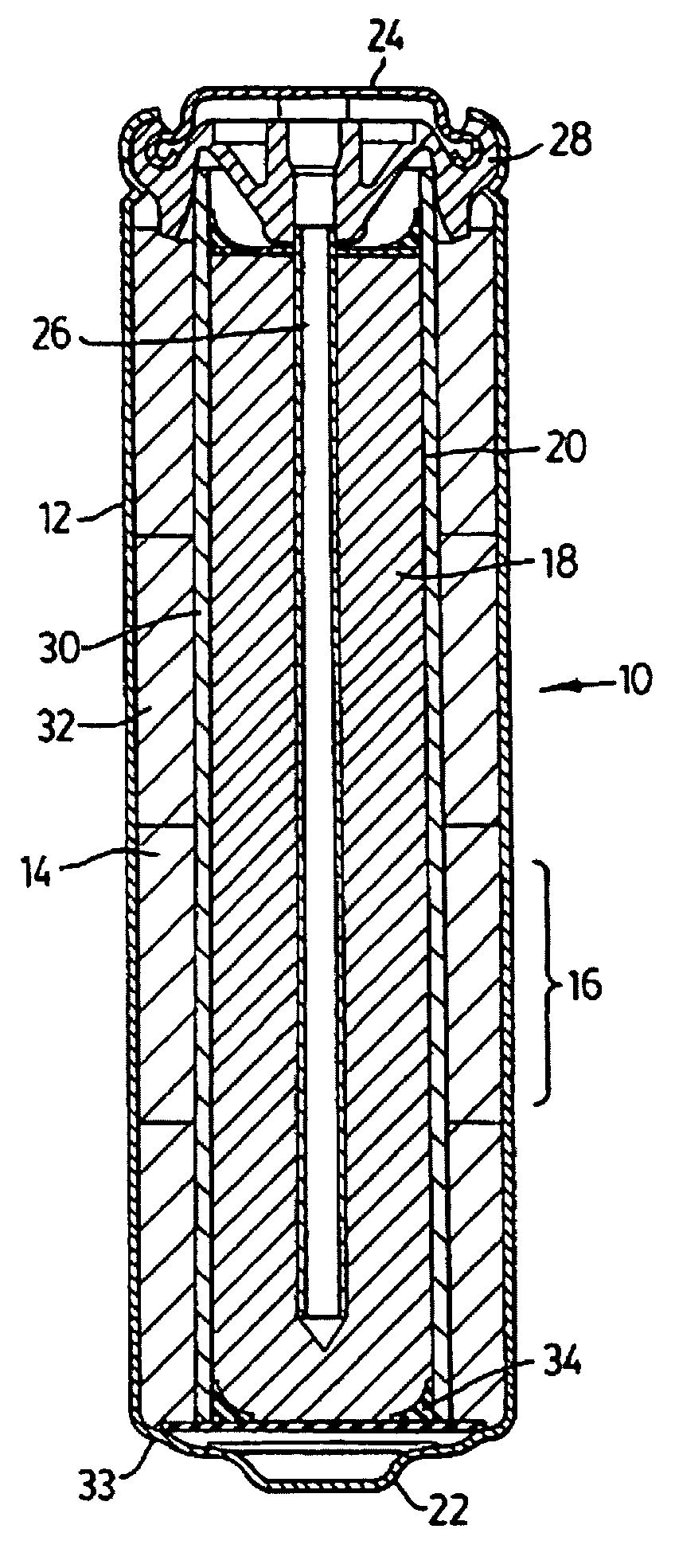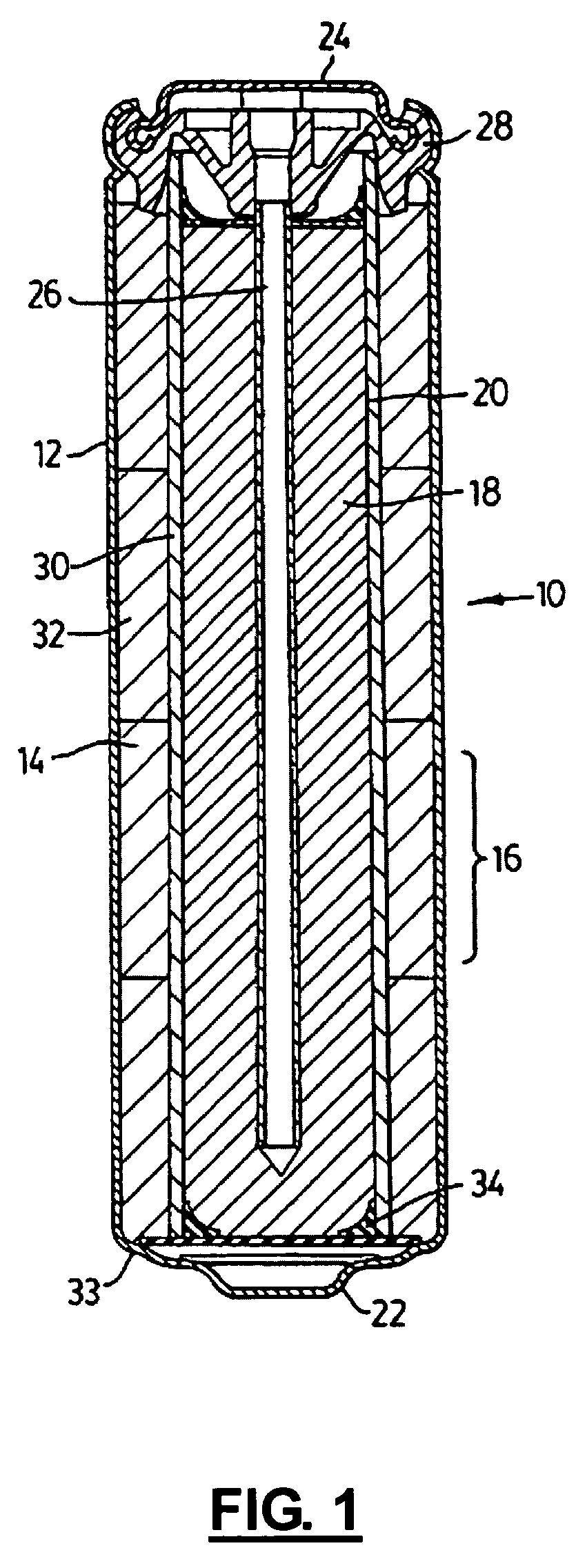Rechargeable alkaline manganese cell having reduced capacity fade and improved cycle life
a rechargeable alkaline manganese and cell technology, applied in the direction of alkaline accumulators, cell components, non-aqueous electrolyte accumulator electrodes, etc., can solve the problems of reducing the available discharge time following each discharge-charge cycle, reducing usefulness, and inclining to prematurely dispose of batteries, so as to increase the cumulative discharge capacity, increase the individual discharge capacity, and high discharge capacity
- Summary
- Abstract
- Description
- Claims
- Application Information
AI Technical Summary
Benefits of technology
Problems solved by technology
Method used
Image
Examples
example 1
[0036]AA-size rechargeable alkaline cells were prepared as described in U.S. Pat. No. 5,300,371 and the above description, except that various additives were combined with the positive electrode material. In this example, four prior art cathode formulations are compared to five comparative test groups according to the present invention.
[0037]The additives for the prior art test cells comprised BaSO4 and a BaSO4 / CaO combinations as indicated in Table 1a below. Prior Art 1 was selected as the typical formulation for rechargeable alkaline cells most commonly sold on the market today and is based on the Taucher et al. prior art WO 93 / 12551. The best overall AA formula, as shown in Table 3 of this patent, is 5% BaSO4, which was chosen for Prior Art 1. Prior Art 2 & 3 examples are based on the Daniel-Ivad et al prior art U.S. Pat. No. 6,361,899, which teaches a two additive approach for better performance. The formulation of Prior Art 2 example was modeled from example 3 of the '899 paten...
example 2
[0047]AA-size rechargeable alkaline cells were prepared and tested similar to example 1 except that the total additive range was increased to 7.9% and 9.75% as shown in Table 2a.
[0048]Table 2b shows the average discharge capacity of the test cells on the 25th and 50th discharge as well as the cumulative capacity obtained in 25 and 50 cycles. The term cumulative capacity means the sum of all individual discharge capacities over the tested number of cycles. The given data represent the average of 4 cells per test in each group.
[0049]
TABLE 2aAdditive composition for cathodes in Example 2CathodeAnodeAdditive CompositionGroup#Ahg MnO2AhBalanceBaSO4B8WS8WCaOCoACaStTotalPriorArt12.437.882.31 95%5.00%0%0% 0%0%0%5.00%PriorArt22.437.882.31 95%5.00%0%0%1.00%0%0%6.00%PriorArt32.367.662.31 98%7.15%0%0%0.25%0%0%7.40%PriorArt42.197.102.31106%15.00% 0%0% 0%0%0%15.00% Test#62.277.362.31102% 0%1.00% 6.50% 0.25%0.15% 0%7.90%Test#72.267.342.31102% 0%1.00% 6.75% 0%0.15% 0%7.90%Test#82.277.37...
example 3
[0052]Since all additive levels in example 1 and 2 showed improved performance over prior art, AA-size rechargeable alkaline cells were prepared and tested similar to example 1 except that the total additive range was further increased from 7.4% up to 20% as shown in Table 3a. In this test series, calcium stearate was used rather than Coathylene™ for improved cathode pellet pressing characteristics as described in U.S. Pat. Appl. No. 2005 / 0164076.
[0053]
TABLE 3aAdditive composition for cathodes in Example 3CathodeAnodeAdditive CompositionGroup#Ahg MnO2AhBalanceBaSO4B8WS8WCaOCoACaStTotalPriorArt12.437.882.31 95%5.00% 0% 0%0%0% 0%5.00%PriorArt22.437.882.31 95%5.00% 0% 0%1.00% 0% 0%6.00%PriorArt32.367.662.31 98%7.15% 0% 0%0.25% 0% 0%7.40%PriorArt42.197.102.31106%15.00% 0% 0%0%0% 0%15.00% Test#92.287.392.31101%0%1.00% 6.00%0%0%0.40%7.40%Test#102.257.312.31103%0%1.00% 6.50%0%0%0.40%7.90%Test#112.167.012.31107%0%1.00% 8.35%0%0%0.40%9.75%Test#122.046.622.31113%0%1...
PUM
| Property | Measurement | Unit |
|---|---|---|
| thickness | aaaaa | aaaaa |
| thickness | aaaaa | aaaaa |
| wt % | aaaaa | aaaaa |
Abstract
Description
Claims
Application Information
 Login to View More
Login to View More - R&D
- Intellectual Property
- Life Sciences
- Materials
- Tech Scout
- Unparalleled Data Quality
- Higher Quality Content
- 60% Fewer Hallucinations
Browse by: Latest US Patents, China's latest patents, Technical Efficacy Thesaurus, Application Domain, Technology Topic, Popular Technical Reports.
© 2025 PatSnap. All rights reserved.Legal|Privacy policy|Modern Slavery Act Transparency Statement|Sitemap|About US| Contact US: help@patsnap.com


